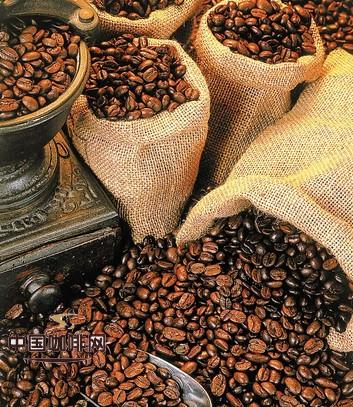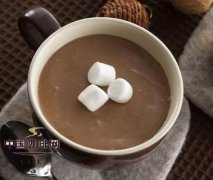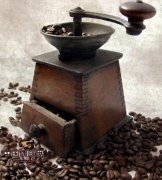Coffee beans three kinds of coffee beans stand side by side

In the face of the accumulation of post-holiday "pear mountain" workload, I believe many people are counting on coffee to save refreshing. However, for a group of senior coffee friends, coffee is like red wine, not instant coffee can be easily fooled. Moreover, taking time off to make a cup of freshly ground coffee for yourself can also be regarded as a moment of relaxation, which is more effective for improving work efficiency. But do you know that coffee beans are actually about origin?
Coffee is coffee, all black, what's the difference? If the coffee beans could say anything, they would probably jump out and say: We all want to talk about our origins! In our opinion, coffee beans are all small black carbon. There are basically three kinds of coffee beans according to their types: arabica, robusta and liberica. Among them, Lobsta is the most important road. It belongs to lowland coffee, has strong disease resistance and the highest yield. It accounts for 60 to 70% of the coffee bean production in the market. It is found in Southeast Asia and West Africa. It is also high in caffeine, instant coffee, canned coffee on the most preferred it.
Arabica is a typical "Gao Ling Hua" belongs to highland coffee, most of the fine coffee in this category, such as Blue Mountain coffee powder in the hearts of the idol class, but also Arabica species. It appears in human history the longest time, it is said that the earliest coffee introduced from the Arab world to the Western world, is Arabica coffee. It is the only coffee that all native species can drink directly, but it has a fatal point is low disease resistance. Sri Lanka was once a famous coffee growing country. Because of a coffee leaf rust, all the Arabica coffee planted in the country went back to the west, and only black tea was planted gloomily. It can be found in South America, Central America, Africa and parts of Asia.
Liberia is the most niche, less flavorful than arabica and without a lot of capital injection, usually only for exchanges between experts or research.
Among the three major coffee beans, the Arabica beans were sought after by players. This is because highland coffee is superior to lowland coffee. Therefore, when commenting on coffee quality, the height of origin is often included in the evaluation criteria. The higher the altitude and the lower the relative temperature, the coffee fruit ripens slowly, so that the fully ripe beans swell well and are easy to roast. In coffee producing countries in Central and South America, the quality of coffee beans is basically evaluated only by the altitude of origin. As for specialty coffee, it's all highland coffee. Of course, if you play more professionally and intensively, most of you will also see whether the coffee has organic certification. The players will recognize: USBA certification, rainforest certification, fair trade certification.
Good birth also depends on baking skills. Because the flavor of coffee beans themselves is hidden, only moderate roasting, in order to seduce its style, just as dry firewood needs fire. According to experts, 80% of the factors that determine the taste of coffee come from green beans and 20% depend on roasting. Roasting is divided into three types: deep, medium and shallow. There is no difference between these three roasting methods. It depends on what kind of roasting method the coffee beans themselves are suitable for. The key lies in the roasting method. If the technique was wrong, even the best beans would be destroyed. The hardest part about roasting coffee is the best time to stop, depending on how the roaster captures the characteristics of the beans. This is determined by experience, by noting the changes in temperature, color, sound, aroma, shape, and luster of the beans.
All coffee contains bitterness and sourness. In general, the lighter the roast, the more sour the coffee. The deeper the roast, the stronger the bitterness. Deep roast for coffee with strong acidity. Light roasting, on the other hand, is suitable for bitter coffees, allowing acidity to be released, easing excessive bitterness and balancing flavors. However, coffee has an expiration date for drinking. No matter how high the roasting method is, drink it up within two weeks after roasting, otherwise the flavor will be greatly reduced.
After the correct picking, preparation and baking, it comes to the last two passes of import, grinding and extraction. These two processes are complementary. The fineness of the powder determines the way coffee is extracted. In general, fine powder is the easiest to extract the essence, so it takes the shortest time, generally 90℃ water, a pass that is taken, with Italian machine and mocha pot. Moderately ground words, usually the family drink their own, to preheat coffee cups and coffee pots in advance, so that the coffee aroma is more prominent, generally 85℃ to 90℃ water temperature, mainly hand flushing pot, drip pot and siphon pot. As for the coarse powder, it should be French pressure pot, the extraction time required is the longest, the water temperature is also between 85℃ and 90℃.
Important Notice :
前街咖啡 FrontStreet Coffee has moved to new addredd:
FrontStreet Coffee Address: 315,Donghua East Road,GuangZhou
Tel:020 38364473
- Prev

The standard of coffee basic knowledge, individual coffee, good coffee
Despite the fact that there are a lot of professional terms used to judge coffee, it is comparable to red wine. In fact, all of them can be dropped, and their own tongue is the first judgment. Mr. Liang said that if the coffee is really good, it is actually very simple: it tastes comfortable, clean, miscellaneous, pure aroma, and the most important thing is that the coffee beans should be fresh. If you put it for a year and a half, Xi Shi will need it.
- Next

Brewing Coffee Basics Single coffee and blend coffee
A single product is coffee beans of a single variety, origin, or roasting degree. Blending refers to coffee beans of different varieties, different origins or (and) different roasting degrees mixed together according to established concepts. When you first fall in love, you may be attracted to a certain trait of the opposite sex, whether beautiful or pure or willful, and you will plunge into the paradise of love. But they fell in love and separated
Related
- Beginners will see the "Coffee pull flower" guide!
- What is the difference between ice blog purified milk and ordinary milk coffee?
- Why is the Philippines the largest producer of crops in Liberia?
- For coffee extraction, should the fine powder be retained?
- How does extracted espresso fill pressed powder? How much strength does it take to press the powder?
- How to make jasmine cold extract coffee? Is the jasmine + latte good?
- Will this little toy really make the coffee taste better? How does Lily Drip affect coffee extraction?
- Will the action of slapping the filter cup also affect coffee extraction?
- What's the difference between powder-to-water ratio and powder-to-liquid ratio?
- What is the Ethiopian local species? What does it have to do with Heirloom native species?

